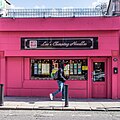Dublin 1 (D1) Baile Átha Cliath 1 | |
|---|---|
Postal district | |
 Clockwise from top: the General Post Office, the Convention Centre, northern O'Connell Street, the Spire of Dublin. | |
| Country | Ireland |
| Province | Leinster |
| Local authority | Dublin City Council |
| Dáil constituency | Dublin Central |
| EP constituency | Dublin |
| Postal district(s) | D1/D01 |
| Dialing code | 01, +353 1 |
Dublin 1, also rendered as D1 and D01, is a postal district on the northside of Dublin, Ireland.





